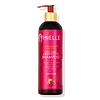What's inside
What's inside
 Key Ingredients
Key Ingredients

No key ingredients
 Benefits
Benefits

 Concerns
Concerns

 Ingredients Side-by-side
Ingredients Side-by-side

Water
Skin ConditioningCetearyl Alcohol
EmollientDistearyldimonium Chloride
Stearamidopropyl Dimethylamine
EmulsifyingBehentrimonium Methosulfate
Cocos Nucifera Oil
MaskingGlycine Soja Oil
EmollientAleurites Moluccanus Seed Oil
Skin ConditioningGalactoarabinan
Cetraria Islandica Extract
CleansingArginine
MaskingTocopherol
AntioxidantGlycerin
HumectantCoco-Glucoside
CleansingLactic Acid
BufferingParfum
MaskingLinalool
PerfumingGeraniol
PerfumingAmyl Cinnamal
PerfumingCitronellol
PerfumingHydroxycitronellal
PerfumingLimonene
PerfumingPotassium Sorbate
PreservativeAscorbyl Palmitate
AntioxidantPhenoxyethanol
PreservativeCaramel
Cosmetic ColorantWater, Cetearyl Alcohol, Distearyldimonium Chloride, Stearamidopropyl Dimethylamine, Behentrimonium Methosulfate, Cocos Nucifera Oil, Glycine Soja Oil, Aleurites Moluccanus Seed Oil, Galactoarabinan, Cetraria Islandica Extract, Arginine, Tocopherol, Glycerin, Coco-Glucoside, Lactic Acid, Parfum, Linalool, Geraniol, Amyl Cinnamal, Citronellol, Hydroxycitronellal, Limonene, Potassium Sorbate, Ascorbyl Palmitate, Phenoxyethanol, Caramel
Water
Skin ConditioningSodium C14-16 Olefin Sulfonate
CleansingCocamidopropyl Betaine
CleansingPolyquaternium-7
Disodium Cocoamphodipropionate
CleansingCocamide Mea
EmulsifyingGlycol Stearate
EmollientDisodium Lauryl Sulfosuccinate
CleansingParfum
MaskingHoney
HumectantPEG-150 Distearate
EmulsifyingPanthenol
Skin ConditioningHydrolyzed Wheat Protein
Skin ConditioningPunica Granatum Seed Oil
EmollientEuterpe Oleracea Fruit Extract
Glycerin
HumectantHydrolyzed Silk
HumectantOrbignya Oleifera Seed Oil
EmollientMauritia Flexuosa Fruit Oil
Skin ConditioningCopaifera Officinalis Resin
MaskingAstrocaryum Murumuru Seed Butter
EmollientSodium Chloride
MaskingCitric Acid
BufferingPhenoxyethanol
PreservativeBenzoic Acid
MaskingEthylhexylglycerin
Skin ConditioningGlycereth-2 Cocoate
EmulsifyingWater, Sodium C14-16 Olefin Sulfonate, Cocamidopropyl Betaine, Polyquaternium-7, Disodium Cocoamphodipropionate, Cocamide Mea, Glycol Stearate, Disodium Lauryl Sulfosuccinate, Parfum, Honey, PEG-150 Distearate, Panthenol, Hydrolyzed Wheat Protein, Punica Granatum Seed Oil, Euterpe Oleracea Fruit Extract, Glycerin, Hydrolyzed Silk, Orbignya Oleifera Seed Oil, Mauritia Flexuosa Fruit Oil, Copaifera Officinalis Resin, Astrocaryum Murumuru Seed Butter, Sodium Chloride, Citric Acid, Phenoxyethanol, Benzoic Acid, Ethylhexylglycerin, Glycereth-2 Cocoate
Ingredients Explained
These ingredients are found in both products.
Ingredients higher up in an ingredient list are typically present in a larger amount.
Glycerin is already naturally found in your skin. It helps moisturize and protect your skin.
A study from 2016 found glycerin to be more effective as a humectant than AHAs and hyaluronic acid.
As a humectant, it helps the skin stay hydrated by pulling moisture to your skin. The low molecular weight of glycerin allows it to pull moisture into the deeper layers of your skin.
Hydrated skin improves your skin barrier; Your skin barrier helps protect against irritants and bacteria.
Glycerin has also been found to have antimicrobial and antiviral properties. Due to these properties, glycerin is often used in wound and burn treatments.
In cosmetics, glycerin is usually derived from plants such as soybean or palm. However, it can also be sourced from animals, such as tallow or animal fat.
This ingredient is organic, colorless, odorless, and non-toxic.
Glycerin is the name for this ingredient in American English. British English uses Glycerol/Glycerine.
Learn more about GlycerinParfum is a catch-all term for an ingredient or more that is used to give a scent to products.
Also called "fragrance", this ingredient can be a blend of hundreds of chemicals or plant oils. This means every product with "fragrance" or "parfum" in the ingredients list is a different mixture.
For instance, Habanolide is a proprietary trade name for a specific aroma chemical. When used as a fragrance ingredient in cosmetics, most aroma chemicals fall under the broad labeling category of “FRAGRANCE” or “PARFUM” according to EU and US regulations.
The term 'parfum' or 'fragrance' is not regulated in many countries. In many cases, it is up to the brand to define this term.
For instance, many brands choose to label themselves as "fragrance-free" because they are not using synthetic fragrances. However, their products may still contain ingredients such as essential oils that are considered a fragrance by INCI standards.
One example is Calendula flower extract. Calendula is an essential oil that still imparts a scent or 'fragrance'.
Depending on the blend, the ingredients in the mixture can cause allergies and sensitivities on the skin. Some ingredients that are known EU allergens include linalool and citronellol.
Parfum can also be used to mask or cover an unpleasant scent.
The bottom line is: not all fragrances/parfum/ingredients are created equally. If you are worried about fragrances, we recommend taking a closer look at an ingredient. And of course, we always recommend speaking with a professional.
Learn more about ParfumPhenoxyethanol is a preservative that has germicide, antimicrobial, and aromatic properties. Studies show that phenoxyethanol can prevent microbial growth. By itself, it has a scent that is similar to that of a rose.
It's often used in formulations along with Caprylyl Glycol to preserve the shelf life of products.
Water. It's the most common cosmetic ingredient of all. You'll usually see it at the top of ingredient lists, meaning that it makes up the largest part of the product.
So why is it so popular? Water most often acts as a solvent - this means that it helps dissolve other ingredients into the formulation.
You'll also recognize water as that liquid we all need to stay alive. If you see this, drink a glass of water. Stay hydrated!
Learn more about Water